Court Observation Assignment
VerifiedAdded on 2022/12/26
|8
|2019
|1
AI Summary
This Court Observation Assignment provides a detailed account of a criminal case observed in the Supreme Court of Victoria. It includes information about the courtroom setting, the type of action, facts of the case, phase of litigation, and observations about the proceedings. The report also explores the appellate jurisdiction of the Supreme Court and the difference between the Commercial Court and the Common Law Division.
Contribute Materials
Your contribution can guide someone’s learning journey. Share your
documents today.
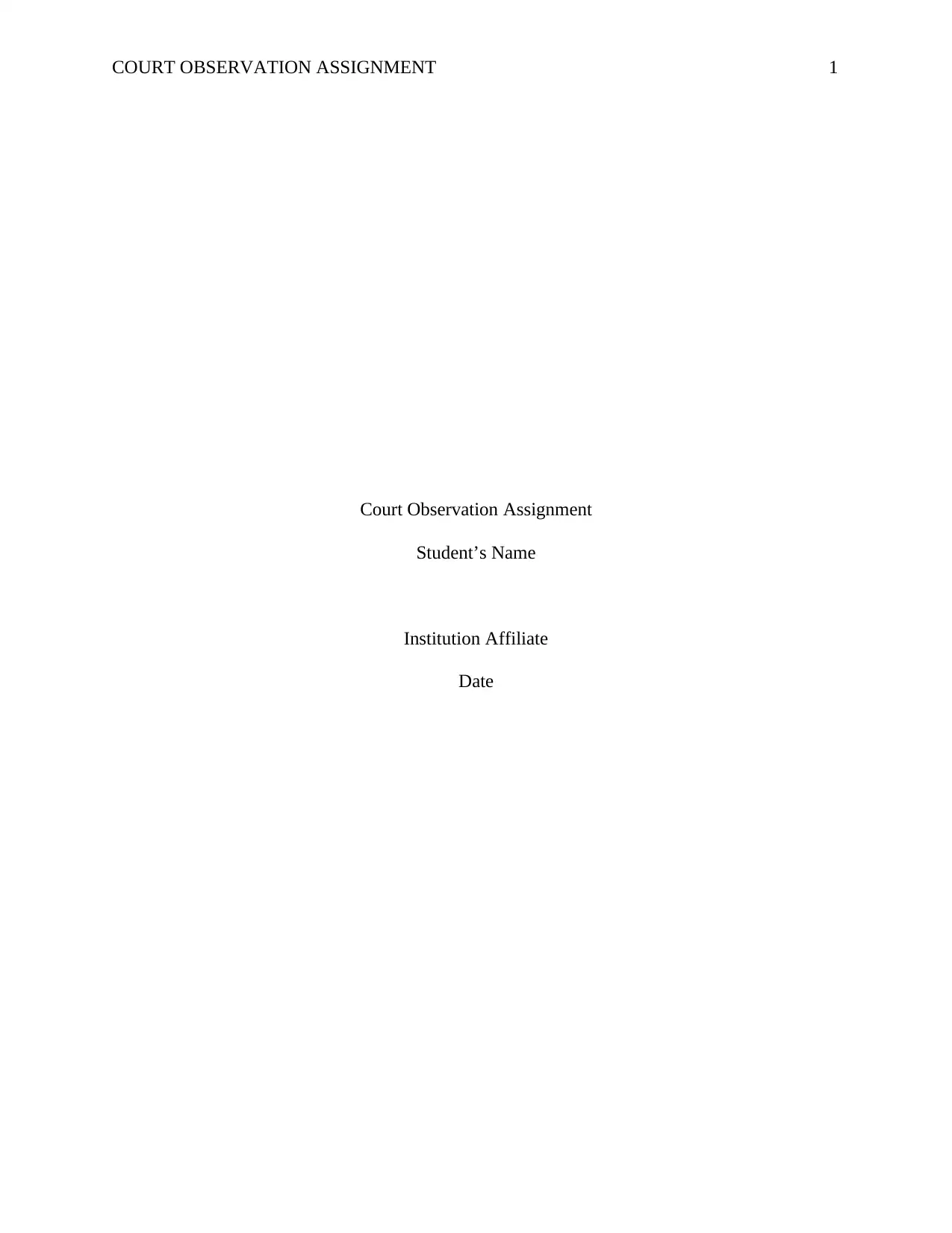
COURT OBSERVATION ASSIGNMENT 1
Court Observation Assignment
Student’s Name
Institution Affiliate
Date
Court Observation Assignment
Student’s Name
Institution Affiliate
Date
Secure Best Marks with AI Grader
Need help grading? Try our AI Grader for instant feedback on your assignments.
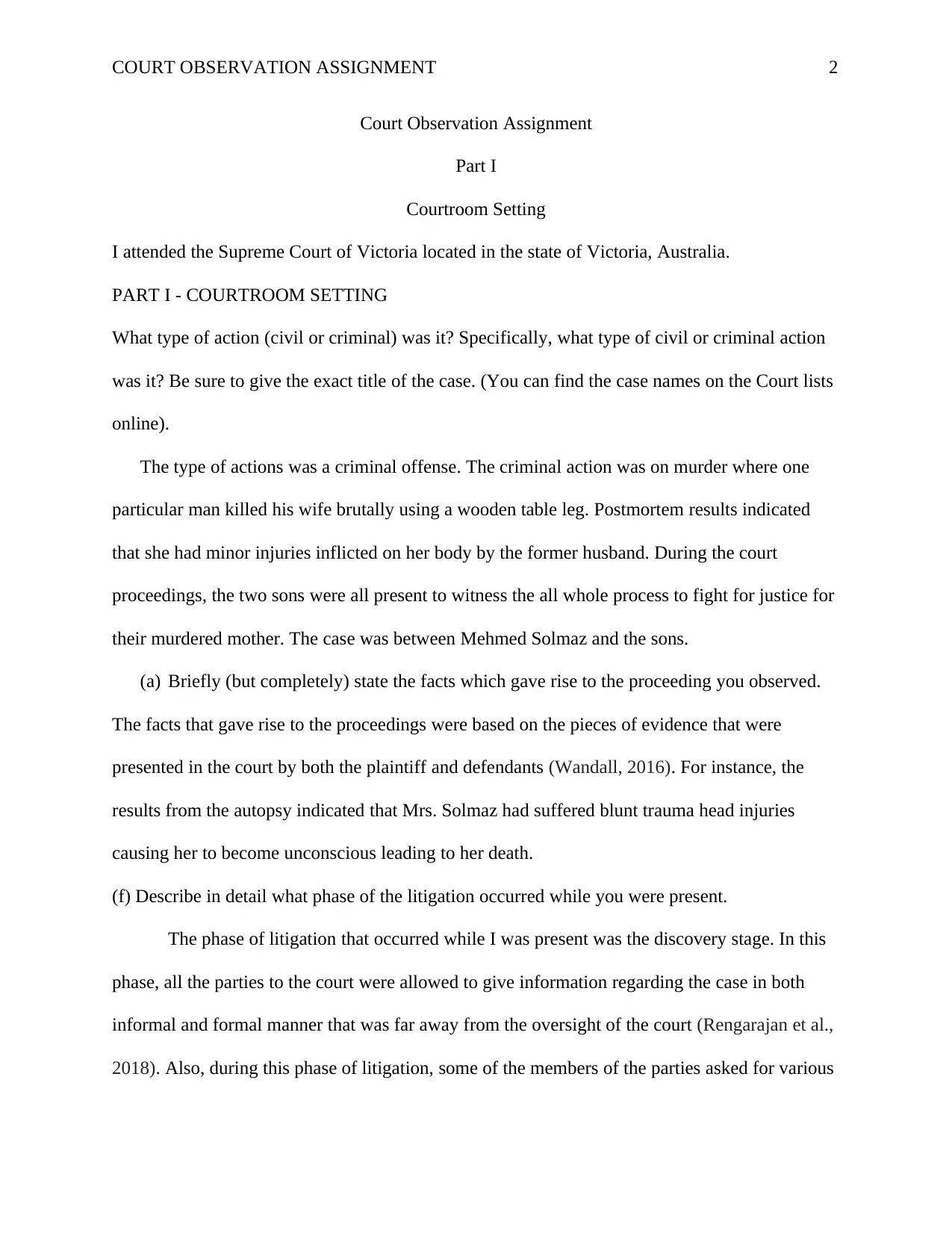
COURT OBSERVATION ASSIGNMENT 2
Court Observation Assignment
Part I
Courtroom Setting
I attended the Supreme Court of Victoria located in the state of Victoria, Australia.
PART I - COURTROOM SETTING
What type of action (civil or criminal) was it? Specifically, what type of civil or criminal action
was it? Be sure to give the exact title of the case. (You can find the case names on the Court lists
online).
The type of actions was a criminal offense. The criminal action was on murder where one
particular man killed his wife brutally using a wooden table leg. Postmortem results indicated
that she had minor injuries inflicted on her body by the former husband. During the court
proceedings, the two sons were all present to witness the all whole process to fight for justice for
their murdered mother. The case was between Mehmed Solmaz and the sons.
(a) Briefly (but completely) state the facts which gave rise to the proceeding you observed.
The facts that gave rise to the proceedings were based on the pieces of evidence that were
presented in the court by both the plaintiff and defendants (Wandall, 2016). For instance, the
results from the autopsy indicated that Mrs. Solmaz had suffered blunt trauma head injuries
causing her to become unconscious leading to her death.
(f) Describe in detail what phase of the litigation occurred while you were present.
The phase of litigation that occurred while I was present was the discovery stage. In this
phase, all the parties to the court were allowed to give information regarding the case in both
informal and formal manner that was far away from the oversight of the court (Rengarajan et al.,
2018). Also, during this phase of litigation, some of the members of the parties asked for various
Court Observation Assignment
Part I
Courtroom Setting
I attended the Supreme Court of Victoria located in the state of Victoria, Australia.
PART I - COURTROOM SETTING
What type of action (civil or criminal) was it? Specifically, what type of civil or criminal action
was it? Be sure to give the exact title of the case. (You can find the case names on the Court lists
online).
The type of actions was a criminal offense. The criminal action was on murder where one
particular man killed his wife brutally using a wooden table leg. Postmortem results indicated
that she had minor injuries inflicted on her body by the former husband. During the court
proceedings, the two sons were all present to witness the all whole process to fight for justice for
their murdered mother. The case was between Mehmed Solmaz and the sons.
(a) Briefly (but completely) state the facts which gave rise to the proceeding you observed.
The facts that gave rise to the proceedings were based on the pieces of evidence that were
presented in the court by both the plaintiff and defendants (Wandall, 2016). For instance, the
results from the autopsy indicated that Mrs. Solmaz had suffered blunt trauma head injuries
causing her to become unconscious leading to her death.
(f) Describe in detail what phase of the litigation occurred while you were present.
The phase of litigation that occurred while I was present was the discovery stage. In this
phase, all the parties to the court were allowed to give information regarding the case in both
informal and formal manner that was far away from the oversight of the court (Rengarajan et al.,
2018). Also, during this phase of litigation, some of the members of the parties asked for various
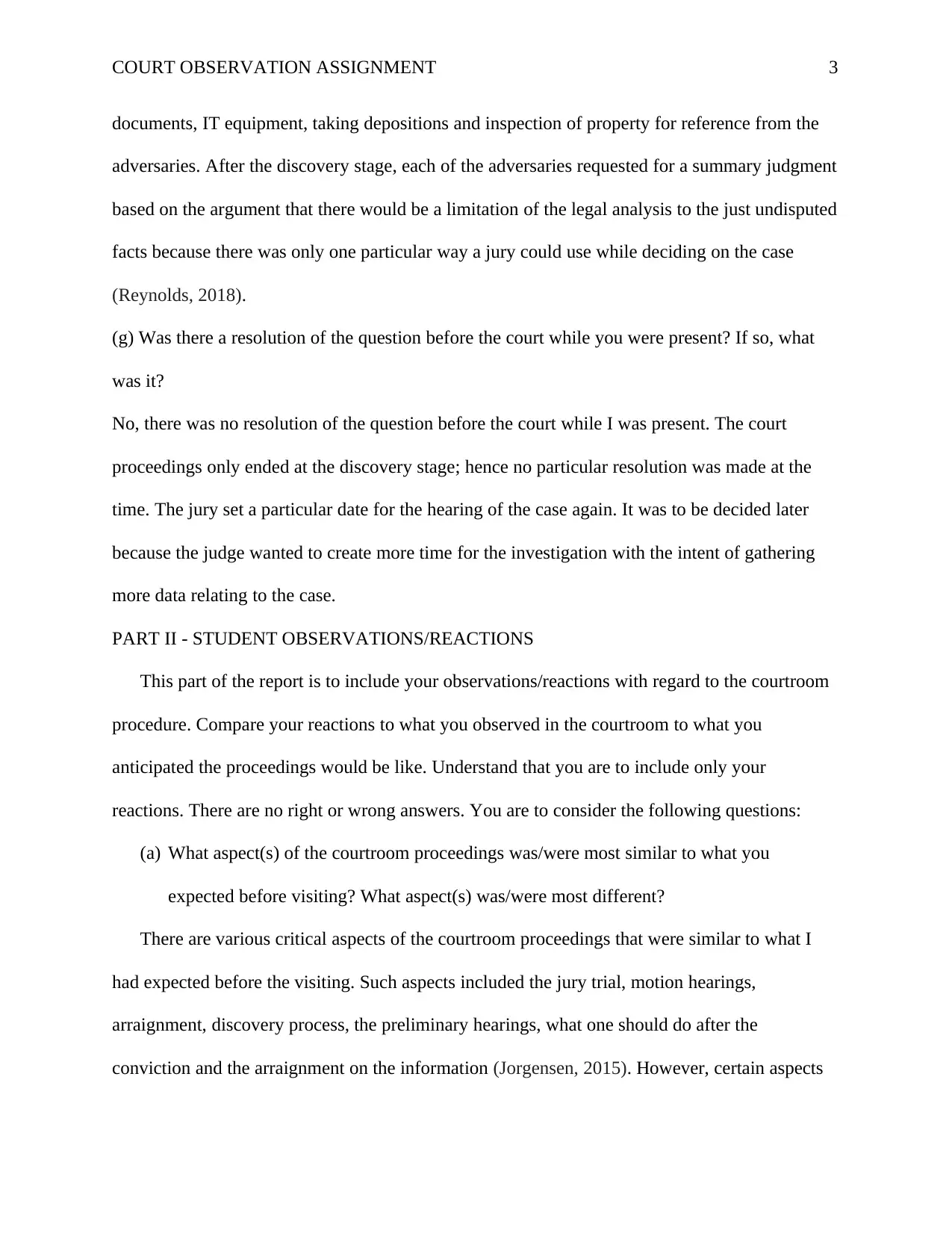
COURT OBSERVATION ASSIGNMENT 3
documents, IT equipment, taking depositions and inspection of property for reference from the
adversaries. After the discovery stage, each of the adversaries requested for a summary judgment
based on the argument that there would be a limitation of the legal analysis to the just undisputed
facts because there was only one particular way a jury could use while deciding on the case
(Reynolds, 2018).
(g) Was there a resolution of the question before the court while you were present? If so, what
was it?
No, there was no resolution of the question before the court while I was present. The court
proceedings only ended at the discovery stage; hence no particular resolution was made at the
time. The jury set a particular date for the hearing of the case again. It was to be decided later
because the judge wanted to create more time for the investigation with the intent of gathering
more data relating to the case.
PART II - STUDENT OBSERVATIONS/REACTIONS
This part of the report is to include your observations/reactions with regard to the courtroom
procedure. Compare your reactions to what you observed in the courtroom to what you
anticipated the proceedings would be like. Understand that you are to include only your
reactions. There are no right or wrong answers. You are to consider the following questions:
(a) What aspect(s) of the courtroom proceedings was/were most similar to what you
expected before visiting? What aspect(s) was/were most different?
There are various critical aspects of the courtroom proceedings that were similar to what I
had expected before the visiting. Such aspects included the jury trial, motion hearings,
arraignment, discovery process, the preliminary hearings, what one should do after the
conviction and the arraignment on the information (Jorgensen, 2015). However, certain aspects
documents, IT equipment, taking depositions and inspection of property for reference from the
adversaries. After the discovery stage, each of the adversaries requested for a summary judgment
based on the argument that there would be a limitation of the legal analysis to the just undisputed
facts because there was only one particular way a jury could use while deciding on the case
(Reynolds, 2018).
(g) Was there a resolution of the question before the court while you were present? If so, what
was it?
No, there was no resolution of the question before the court while I was present. The court
proceedings only ended at the discovery stage; hence no particular resolution was made at the
time. The jury set a particular date for the hearing of the case again. It was to be decided later
because the judge wanted to create more time for the investigation with the intent of gathering
more data relating to the case.
PART II - STUDENT OBSERVATIONS/REACTIONS
This part of the report is to include your observations/reactions with regard to the courtroom
procedure. Compare your reactions to what you observed in the courtroom to what you
anticipated the proceedings would be like. Understand that you are to include only your
reactions. There are no right or wrong answers. You are to consider the following questions:
(a) What aspect(s) of the courtroom proceedings was/were most similar to what you
expected before visiting? What aspect(s) was/were most different?
There are various critical aspects of the courtroom proceedings that were similar to what I
had expected before the visiting. Such aspects included the jury trial, motion hearings,
arraignment, discovery process, the preliminary hearings, what one should do after the
conviction and the arraignment on the information (Jorgensen, 2015). However, certain aspects
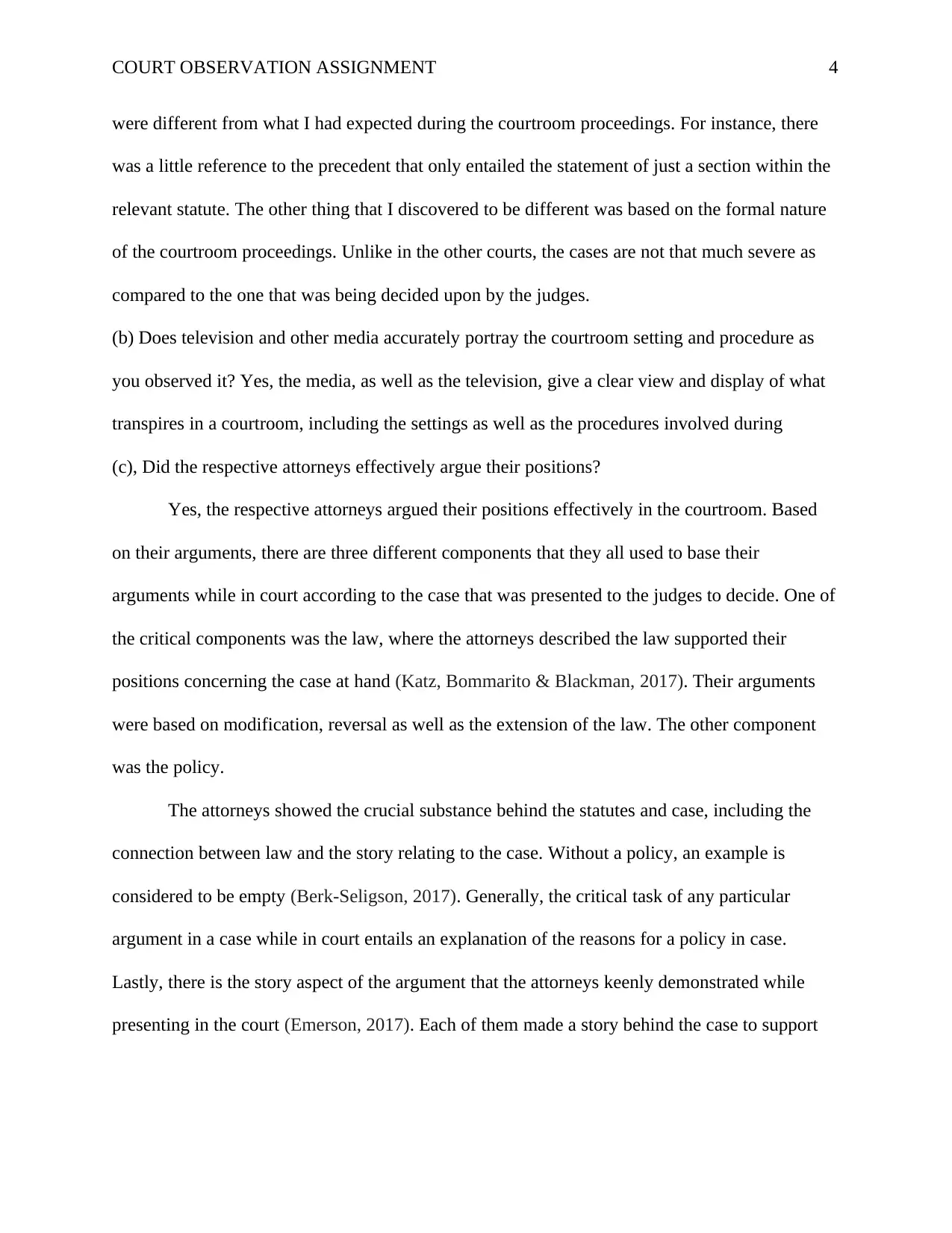
COURT OBSERVATION ASSIGNMENT 4
were different from what I had expected during the courtroom proceedings. For instance, there
was a little reference to the precedent that only entailed the statement of just a section within the
relevant statute. The other thing that I discovered to be different was based on the formal nature
of the courtroom proceedings. Unlike in the other courts, the cases are not that much severe as
compared to the one that was being decided upon by the judges.
(b) Does television and other media accurately portray the courtroom setting and procedure as
you observed it? Yes, the media, as well as the television, give a clear view and display of what
transpires in a courtroom, including the settings as well as the procedures involved during
(c), Did the respective attorneys effectively argue their positions?
Yes, the respective attorneys argued their positions effectively in the courtroom. Based
on their arguments, there are three different components that they all used to base their
arguments while in court according to the case that was presented to the judges to decide. One of
the critical components was the law, where the attorneys described the law supported their
positions concerning the case at hand (Katz, Bommarito & Blackman, 2017). Their arguments
were based on modification, reversal as well as the extension of the law. The other component
was the policy.
The attorneys showed the crucial substance behind the statutes and case, including the
connection between law and the story relating to the case. Without a policy, an example is
considered to be empty (Berk-Seligson, 2017). Generally, the critical task of any particular
argument in a case while in court entails an explanation of the reasons for a policy in case.
Lastly, there is the story aspect of the argument that the attorneys keenly demonstrated while
presenting in the court (Emerson, 2017). Each of them made a story behind the case to support
were different from what I had expected during the courtroom proceedings. For instance, there
was a little reference to the precedent that only entailed the statement of just a section within the
relevant statute. The other thing that I discovered to be different was based on the formal nature
of the courtroom proceedings. Unlike in the other courts, the cases are not that much severe as
compared to the one that was being decided upon by the judges.
(b) Does television and other media accurately portray the courtroom setting and procedure as
you observed it? Yes, the media, as well as the television, give a clear view and display of what
transpires in a courtroom, including the settings as well as the procedures involved during
(c), Did the respective attorneys effectively argue their positions?
Yes, the respective attorneys argued their positions effectively in the courtroom. Based
on their arguments, there are three different components that they all used to base their
arguments while in court according to the case that was presented to the judges to decide. One of
the critical components was the law, where the attorneys described the law supported their
positions concerning the case at hand (Katz, Bommarito & Blackman, 2017). Their arguments
were based on modification, reversal as well as the extension of the law. The other component
was the policy.
The attorneys showed the crucial substance behind the statutes and case, including the
connection between law and the story relating to the case. Without a policy, an example is
considered to be empty (Berk-Seligson, 2017). Generally, the critical task of any particular
argument in a case while in court entails an explanation of the reasons for a policy in case.
Lastly, there is the story aspect of the argument that the attorneys keenly demonstrated while
presenting in the court (Emerson, 2017). Each of them made a story behind the case to support
Secure Best Marks with AI Grader
Need help grading? Try our AI Grader for instant feedback on your assignments.

COURT OBSERVATION ASSIGNMENT 5
their arguments. The above mentioned components confirm that indeed the attorneys argued
their positions effectively.
(d) Did the physical environment of the courtroom lend itself to the orderly and professional
conduct of judicial matters? Comment on your reaction to the physical setting itself.
You may also include any other pertinent observations that you made.
My observations of the conduct of the judges throughout the pre-trials were that they
were professional, organized and personal. Such a conduct of the judges was as a result of the
conducive physical environment that created a room for the professional and conduct of judicial
matters. Everything was fully arranged and packed in an orderly manner to allow for the smooth
proceedings in the court. Almost everyone in the courtroom had his or her seat to avoid any
particular physical movement.
Also, all the judges were seated at the front facing the audience, and this enabled
different individuals to listen to the spoken words of both the judges as well as the attorneys. I
was astonished by what I saw, the orderly, organized and well-arranged courtroom that created a
conducive space for the hearing of the cases. Everyone who was involved in the hearing and
arguing on the case was audible; thus, we could all hear different views on the case from where
we sat. I want to work in such an environment, and this is because of the orderly and organized
manner of the courtroom (Spradley, 2016). This can typically help turn the lives of the kids
around as well as point their lives in the right direction towards a successful life in the future.
PART III: RESEARCH COMPONENT:
The research component of this paper will explore the following:
a) Supreme Court Appeals: Describe the appellate (appeals) jurisdiction of the Supreme
Court. How many judges usually sit on the bench of Supreme Court Appeals cases?
their arguments. The above mentioned components confirm that indeed the attorneys argued
their positions effectively.
(d) Did the physical environment of the courtroom lend itself to the orderly and professional
conduct of judicial matters? Comment on your reaction to the physical setting itself.
You may also include any other pertinent observations that you made.
My observations of the conduct of the judges throughout the pre-trials were that they
were professional, organized and personal. Such a conduct of the judges was as a result of the
conducive physical environment that created a room for the professional and conduct of judicial
matters. Everything was fully arranged and packed in an orderly manner to allow for the smooth
proceedings in the court. Almost everyone in the courtroom had his or her seat to avoid any
particular physical movement.
Also, all the judges were seated at the front facing the audience, and this enabled
different individuals to listen to the spoken words of both the judges as well as the attorneys. I
was astonished by what I saw, the orderly, organized and well-arranged courtroom that created a
conducive space for the hearing of the cases. Everyone who was involved in the hearing and
arguing on the case was audible; thus, we could all hear different views on the case from where
we sat. I want to work in such an environment, and this is because of the orderly and organized
manner of the courtroom (Spradley, 2016). This can typically help turn the lives of the kids
around as well as point their lives in the right direction towards a successful life in the future.
PART III: RESEARCH COMPONENT:
The research component of this paper will explore the following:
a) Supreme Court Appeals: Describe the appellate (appeals) jurisdiction of the Supreme
Court. How many judges usually sit on the bench of Supreme Court Appeals cases?

COURT OBSERVATION ASSIGNMENT 6
The appellate jurisdiction of the Supreme Court is the power and authority of the court to
assess, amend and overrule on the decisions made by the lower courts. Some of such appellate
jurisdiction are developed legislatively and could entail of several appeals by right as well as the
leave of the appellate court (Llewellyn, 2016). According to the constitution of Australia, there
are usually seven judges that sit on the bench of the Supreme Court Appeal cases. The number of
judges sitting in the bench works under sections 71 to 75 of the constitution, the High Court of
Australia Act 1979 and the Judiciary Act. Currently, the seven bench judge is led by the chief
justice of Australia called, Susan Kiefel (Chemerinsky, 2018).
b) What is the difference between the Commercial Court of the Supreme Court and the
Common Law Division?
The common law division is a court that is involved in the management of different
groups of cases relating to tort, contract, claims regarding to estates and wills as well as property
law. Other cases relate to proceedings of the supervisory jurisdiction of the court (Ashworth &
Perera, 2018). The commercial court of the Supreme Court, however, deals with cases relating to
commercial litigation. The commercial litigations include shareholder issues, partnership
disputes, breach of contract and class actions among others. Such a court mainly hears business
disputes using simplified procedures (Moore et al., 2017). The primary reason for the formation
of the commercial supreme courts is to quicken the trials.
The appellate jurisdiction of the Supreme Court is the power and authority of the court to
assess, amend and overrule on the decisions made by the lower courts. Some of such appellate
jurisdiction are developed legislatively and could entail of several appeals by right as well as the
leave of the appellate court (Llewellyn, 2016). According to the constitution of Australia, there
are usually seven judges that sit on the bench of the Supreme Court Appeal cases. The number of
judges sitting in the bench works under sections 71 to 75 of the constitution, the High Court of
Australia Act 1979 and the Judiciary Act. Currently, the seven bench judge is led by the chief
justice of Australia called, Susan Kiefel (Chemerinsky, 2018).
b) What is the difference between the Commercial Court of the Supreme Court and the
Common Law Division?
The common law division is a court that is involved in the management of different
groups of cases relating to tort, contract, claims regarding to estates and wills as well as property
law. Other cases relate to proceedings of the supervisory jurisdiction of the court (Ashworth &
Perera, 2018). The commercial court of the Supreme Court, however, deals with cases relating to
commercial litigation. The commercial litigations include shareholder issues, partnership
disputes, breach of contract and class actions among others. Such a court mainly hears business
disputes using simplified procedures (Moore et al., 2017). The primary reason for the formation
of the commercial supreme courts is to quicken the trials.

COURT OBSERVATION ASSIGNMENT 7
References
Ashworth, A., & Perera, S. (2018). Contractual procedures in the construction industry.
Routledge.
Berk-Seligson, S. (2017). The bilingual courtroom: Court interpreters in the judicial process.
University of Chicago Press.
Chemerinsky, E. (2018). Aspen Treatise for Federal Jurisdiction. Aspen Publishers.
Emerson, R. M. (2017). Judging delinquents: Context and process in juvenile court. Routledge.
Jorgensen, D. L. (2015). Participant observation. Emerging trends in the social and behavioral
sciences: An interdisciplinary, searchable, and linkable resource, 1-15.
Katz, D. M., Bommarito II, M. J., & Blackman, J. (2017). A general approach for predicting the
behavior of the Supreme Court of the United States. PloS one, 12(4), e0174698.
Llewellyn, K. N. (2016). The common law tradition: Deciding appeals (Vol. 16). Quid Pro
Books.
Moore, R., Murray, M., Farrell, M., & Youm, K. H. (2017). Media Law and Ethics. Routledge.
Rengarajan, S., Palaniyappan, D., Ramachandran, P., & Ramachandran, R. (2018). National
Green Tribunal of India—an observation from environmental judgments. Environmental
Science and Pollution Research, 1-6.
Reynolds, D. (2018). An Implied Freedom of Political Observation in the Australian
Constitution. Melb. UL Rev., 42, 199.
References
Ashworth, A., & Perera, S. (2018). Contractual procedures in the construction industry.
Routledge.
Berk-Seligson, S. (2017). The bilingual courtroom: Court interpreters in the judicial process.
University of Chicago Press.
Chemerinsky, E. (2018). Aspen Treatise for Federal Jurisdiction. Aspen Publishers.
Emerson, R. M. (2017). Judging delinquents: Context and process in juvenile court. Routledge.
Jorgensen, D. L. (2015). Participant observation. Emerging trends in the social and behavioral
sciences: An interdisciplinary, searchable, and linkable resource, 1-15.
Katz, D. M., Bommarito II, M. J., & Blackman, J. (2017). A general approach for predicting the
behavior of the Supreme Court of the United States. PloS one, 12(4), e0174698.
Llewellyn, K. N. (2016). The common law tradition: Deciding appeals (Vol. 16). Quid Pro
Books.
Moore, R., Murray, M., Farrell, M., & Youm, K. H. (2017). Media Law and Ethics. Routledge.
Rengarajan, S., Palaniyappan, D., Ramachandran, P., & Ramachandran, R. (2018). National
Green Tribunal of India—an observation from environmental judgments. Environmental
Science and Pollution Research, 1-6.
Reynolds, D. (2018). An Implied Freedom of Political Observation in the Australian
Constitution. Melb. UL Rev., 42, 199.
Paraphrase This Document
Need a fresh take? Get an instant paraphrase of this document with our AI Paraphraser
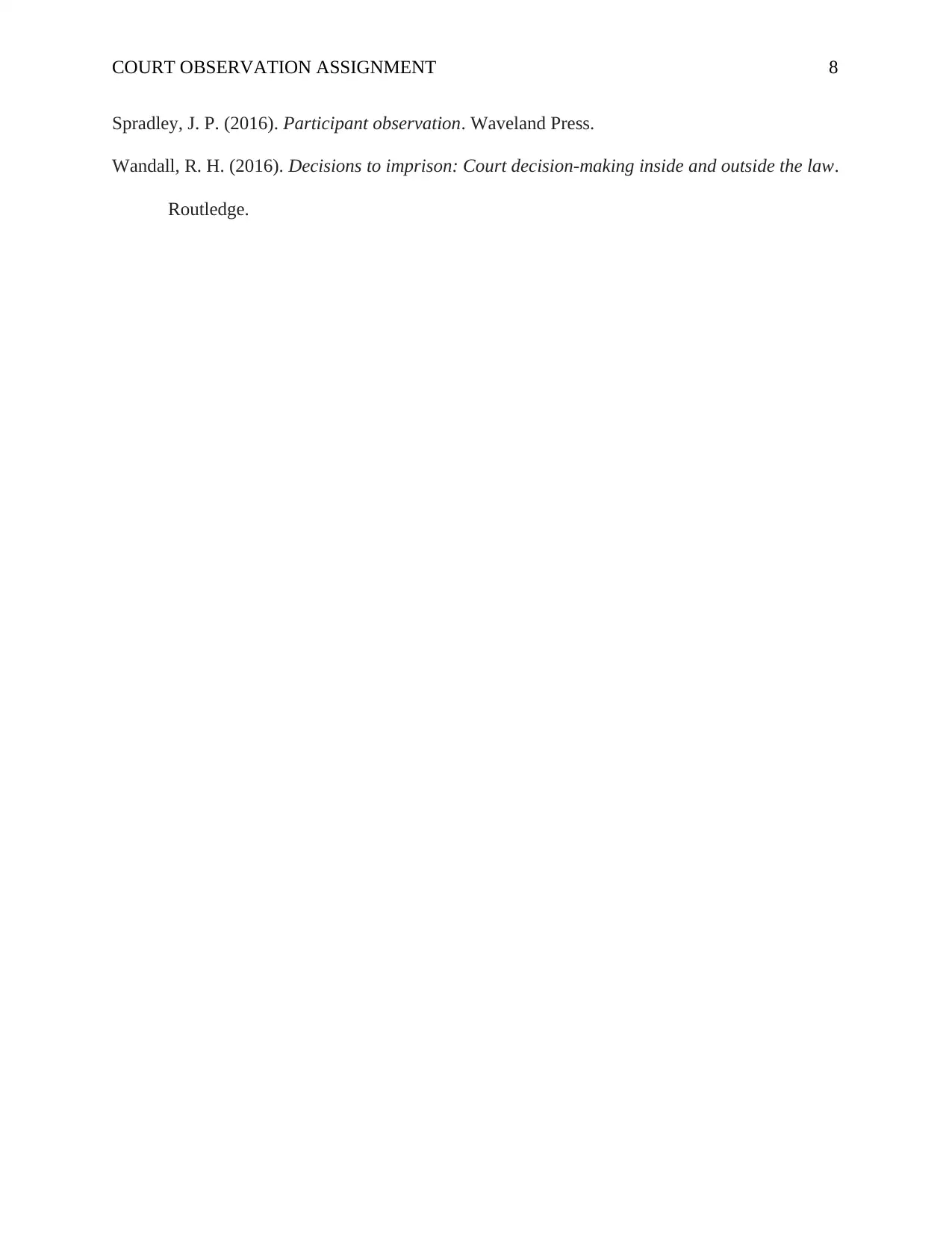
COURT OBSERVATION ASSIGNMENT 8
Spradley, J. P. (2016). Participant observation. Waveland Press.
Wandall, R. H. (2016). Decisions to imprison: Court decision-making inside and outside the law.
Routledge.
Spradley, J. P. (2016). Participant observation. Waveland Press.
Wandall, R. H. (2016). Decisions to imprison: Court decision-making inside and outside the law.
Routledge.
1 out of 8
Your All-in-One AI-Powered Toolkit for Academic Success.
+13062052269
info@desklib.com
Available 24*7 on WhatsApp / Email
![[object Object]](/_next/static/media/star-bottom.7253800d.svg)
Unlock your academic potential
© 2024 | Zucol Services PVT LTD | All rights reserved.

